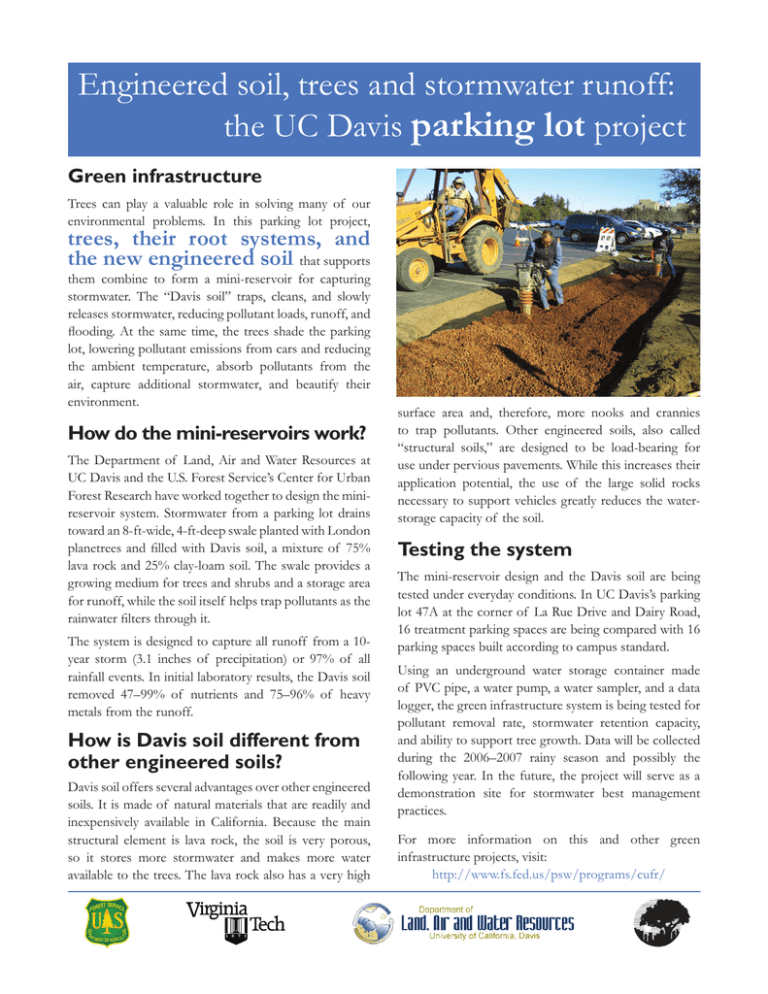parking lot Engineered soil, trees and stormwater runoff: the UC Davis
advertisement

Engineered soil, trees and stormwater runoff: the UC Davis parking lot project Green infrastructure Trees can play a valuable role in solving many of our environmental problems. In this parking lot project, trees, their root systems, and the new engineered soil that supports them combine to form a mini-reservoir for capturing stormwater. The “Davis soil” traps, cleans, and slowly releases stormwater, reducing pollutant loads, runoff, and flooding. At the same time, the trees shade the parking lot, lowering pollutant emissions from cars and reducing the ambient temperature, absorb pollutants from the air, capture additional stormwater, and beautify their environment. How do the mini-reservoirs work? The Department of Land, Air and Water Resources at UC Davis and the U.S. Forest Service’s Center for Urban Forest Research have worked together to design the minireservoir system. Stormwater from a parking lot drains toward an 8-ft-wide, 4-ft-deep swale planted with London planetrees and filled with Davis soil, a mixture of 75% lava rock and 25% clay-loam soil. The swale provides a growing medium for trees and shrubs and a storage area for runoff, while the soil itself helps trap pollutants as the rainwater filters through it. The system is designed to capture all runoff from a 10year storm (3.1 inches of precipitation) or 97% of all rainfall events. In initial laboratory results, the Davis soil removed 47–99% of nutrients and 75–96% of heavy metals from the runoff. How is Davis soil different from other engineered soils? Davis soil offers several advantages over other engineered soils. It is made of natural materials that are readily and inexpensively available in California. Because the main structural element is lava rock, the soil is very porous, so it stores more stormwater and makes more water available to the trees. The lava rock also has a very high surface area and, therefore, more nooks and crannies to trap pollutants. Other engineered soils, also called “structural soils,” are designed to be load-bearing for use under pervious pavements. While this increases their application potential, the use of the large solid rocks necessary to support vehicles greatly reduces the waterstorage capacity of the soil. Testing the system The mini-reservoir design and the Davis soil are being tested under everyday conditions. In UC Davis’s parking lot 47A at the corner of La Rue Drive and Dairy Road, 16 treatment parking spaces are being compared with 16 parking spaces built according to campus standard. Using an underground water storage container made of PVC pipe, a water pump, a water sampler, and a data logger, the green infrastructure system is being tested for pollutant removal rate, stormwater retention capacity, and ability to support tree growth. Data will be collected during the 2006–2007 rainy season and possibly the following year. In the future, the project will serve as a demonstration site for stormwater best management practices. For more information on this and other green infrastructure projects, visit: http://www.fs.fed.us/psw/programs/cufr/ The USDA is an equal opportunity provider and employer.





